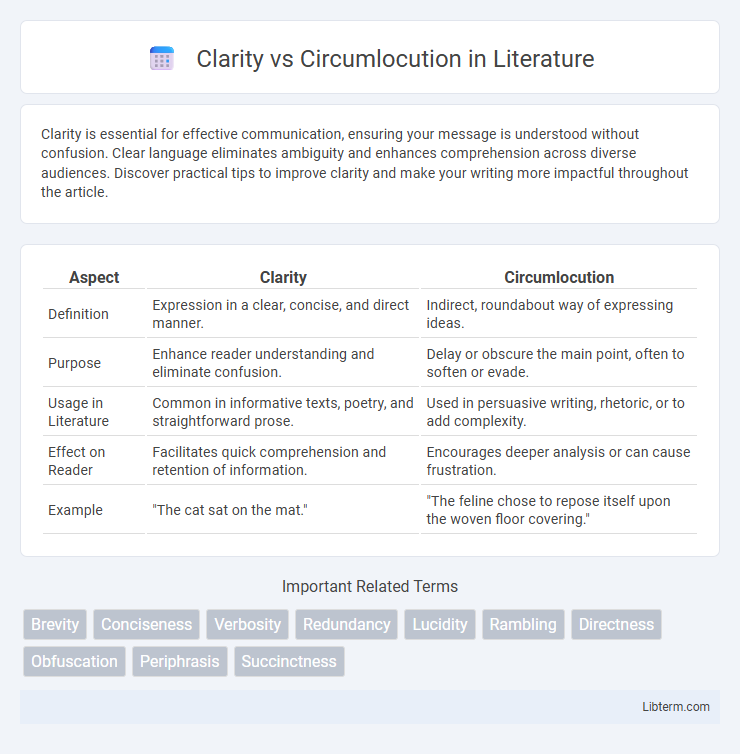Clarity is essential for effective communication, ensuring your message is understood without confusion. Clear language eliminates ambiguity and enhances comprehension across diverse audiences. Discover practical tips to improve clarity and make your writing more impactful throughout the article.
Table of Comparison
| Aspect | Clarity | Circumlocution |
|---|---|---|
| Definition | Expression in a clear, concise, and direct manner. | Indirect, roundabout way of expressing ideas. |
| Purpose | Enhance reader understanding and eliminate confusion. | Delay or obscure the main point, often to soften or evade. |
| Usage in Literature | Common in informative texts, poetry, and straightforward prose. | Used in persuasive writing, rhetoric, or to add complexity. |
| Effect on Reader | Facilitates quick comprehension and retention of information. | Encourages deeper analysis or can cause frustration. |
| Example | "The cat sat on the mat." | "The feline chose to repose itself upon the woven floor covering." |
Understanding Clarity in Communication
Clarity in communication involves expressing ideas in a straightforward and precise manner that minimizes confusion and enhances comprehension. Using clear language, specific terms, and concise sentences helps recipients grasp the intended message quickly and accurately. Avoiding circumlocution, or unnecessary verbosity, improves information retention and facilitates effective knowledge transfer.
Defining Circumlocution
Circumlocution involves using unnecessarily wordy or indirect language to express an idea, often obscuring the main point. Unlike clarity, which emphasizes precise and straightforward communication, circumlocution can lead to confusion and misinterpretation. In writing and speech, avoiding circumlocution enhances understanding and strengthens the impact of the message.
The Importance of Direct Language
Direct language enhances clarity by eliminating ambiguity and allowing the audience to grasp the intended message quickly. Clear communication reduces misunderstandings and improves efficiency in both personal and professional interactions. Prioritizing straightforward expressions fosters trust and ensures that key points are conveyed without unnecessary complexity.
Common Causes of Circumlocution
Circumlocution often arises from limited vocabulary, anxiety, or uncertainty about the topic, leading speakers to use indirect or overly complex expressions instead of clear and direct language. This tendency results in longer explanations that obscure the main point, reducing communication efficiency and clarity. Understanding these common causes helps improve linguistic precision and enhances overall discourse effectiveness.
Effects of Clarity on Audience Engagement
Clarity enhances audience engagement by facilitating easier comprehension and retention of information, leading to increased trust and interest. Clear communication reduces cognitive load, allowing audiences to process messages efficiently and respond more positively. Avoiding circumlocution eliminates confusion and frustration, creating a smoother interaction that fosters stronger connections and sustained attention.
How Circumlocution Impacts Understanding
Circumlocution reduces clarity by using excessive or indirect language that complicates the intended message, leading to confusion and misinterpretation. This verbose communication style increases cognitive load, making it harder for readers or listeners to grasp key points efficiently. In contrast, clarity facilitates immediate comprehension by presenting ideas in straightforward, concise terms.
Strategies for Achieving Clarity
Effective strategies for achieving clarity include using precise vocabulary, structuring sentences logically, and avoiding unnecessary jargon or redundancy. Employing active voice and concise phrasing enhances comprehension by directly conveying the intended message. Regular revision and seeking feedback can further eliminate ambiguity and ensure clear communication.
Recognizing and Avoiding Circumlocution
Recognizing circumlocution involves identifying overly complex or indirect phrases that obscure the intended message, often leading to confusion or misinterpretation. Avoiding circumlocution requires using precise vocabulary and straightforward sentence structures to convey ideas clearly and efficiently. Emphasizing clarity enhances communication effectiveness, ensuring the audience comprehends the message without unnecessary elaboration or ambiguity.
Practical Examples: Clarity vs Circumlocution
Clarity enhances communication by using straightforward language, such as saying "The project is delayed" instead of "There are unforeseen circumstances affecting the timeline." Circumlocution often obscures meaning, as in "The temporal progression of the task schedule has experienced unanticipated extensions," which can confuse the audience. Practical examples demonstrate that clear, concise wording improves understanding and efficiency in both written and verbal exchanges.
Choosing Clarity: Best Practices for Effective Communication
Choosing clarity in communication enhances understanding, reduces misinterpretation, and fosters efficient information exchange. Best practices include using precise vocabulary, structuring sentences simply, and avoiding unnecessary jargon or filler words that cause confusion. Clear communication improves collaboration, decision-making, and overall message impact in professional and personal contexts.
Clarity Infographic

 libterm.com
libterm.com